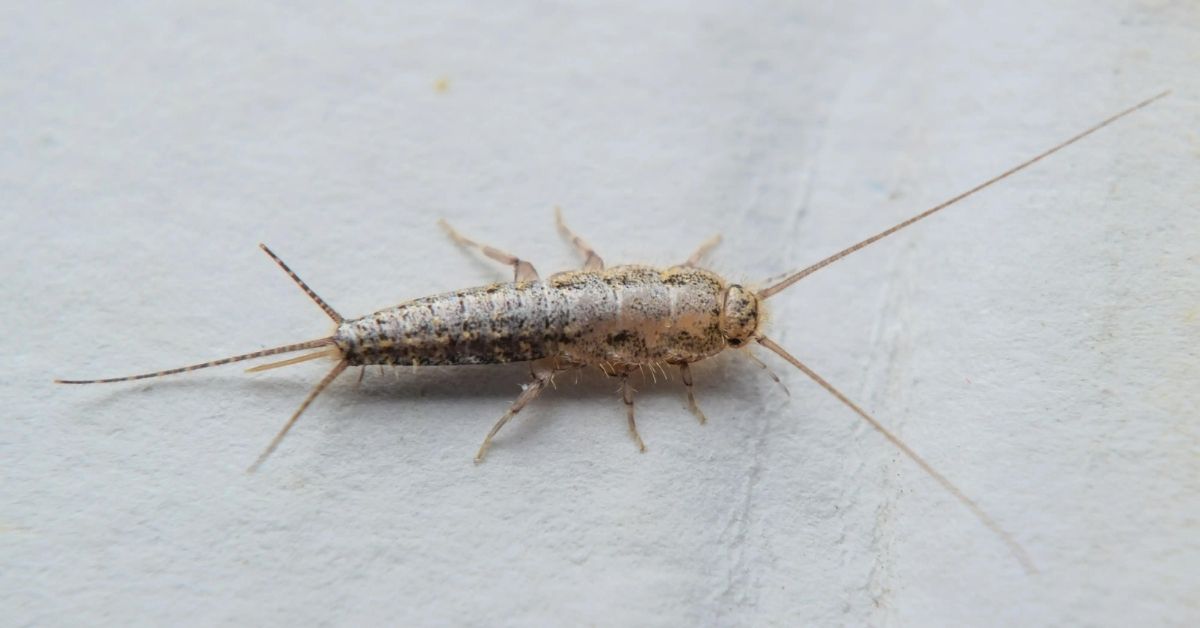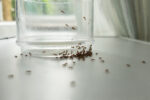
What Silverfish Are, Where They Come From, & How to Get Rid of Them
If you have seen small silver insects that exhibit almost fish-like movement around your home, you may be wondering how to get rid of silverfish. Most of us remember the first time we saw these distinctive creepy crawlies scurrying around. When these prehistoric-looking insects show up in your space, you need every tool available to expel them from your home. The silverfish experts at Hulett have you covered with our guide on how to get rid of silverfish.
What Are Silverfish?
Silverfish (Lepisma saccharina) are known by many names: fishmoth, carpet shark insect, or urban silverfish. Their common name comes from their silvery metallic color and the way they move their bodies. Their movements resemble the side-to-side movements that fish make as they travel through the water. These nocturnal pests range from one-third to one-half inch in length and have three appendages protruding from the posterior part of their abdomen called caudal segments, a great way to make a proper identification.
Surprisingly, these insects typically live three to five years but can live for up to eight. Although their litters are small, they reproduce often over the course of their long lives, producing up to 100 eggs. Most of us do not want to share our living spaces for years with these long-lived pests.
Are Silverfish Harmful?
Silverfish have chewing mouthparts and they are known to chew on household items if you have an infestation. Silverfish can chew holes in important documents, papers, pet food, stored boxes and goods, or even clothing. If you start to see these holes in your items, silverfish may be the culprit. After consuming holes in your items, Silverfish are also known for leaving droppings scattered around your home where their hide, which no one wants.
Why Do I Have Silverfish?
Your home has a lot to offer silverfish. Like many insects, silverfish venture indoors in search of food, water, and shelter. They prefer moist, humid environments, which are plentiful in South Florida. They may want to lay their eggs in the dark, moist areas of your home. Some things are more likely to draw these insects to your property:
- Cardboard boxes
- Humidity in rooms
- Household paper and debris for feeding
- Moist leaf piles
- Piles of wood or construction materials
- Heavily weeded areas
- Clogged or broken gutters
- Leaky spigots
- Objects that prevent the ground from drying
- Mulch
If you are a book or document collector, a silverfish sighting is an emergency. They can destroy precious items, such as book collections, vintage clothing, and antiques. Materials like paper, glue, and textiles are very appealing to them. When they feed on your vintage silk blouse or prized collection of rare books, they leave behind light gray to dark stains, as well as their scales and waste. Even worse, they create holes when they feed. If you have an irreplaceable, priceless collection in your home, you cannot afford to let a silverfish problem go unaddressed. Contact a pest control company immediately to protect your beautiful, priceless collection.
How to Get Rid of Silverfish
These unusual looking pests are creepy and can send you scrambling to get rid of them. For small infestations, homeowners may be tempted to make homemade traps like using paper with double sided sticky tape for when silverfish and other insects walk across them, they get stuck and expire. Or by placing food inside a glass jar that is textured for crawling on the exterior of the jar, but smooth on the interior surface of the jar so the insect gets stuck and is unable to escape after crawling into the jar trying to feed on the food that was placed as bait. However, these methods are often not as effective as professional pest control, where trained technicians use professional-grade products, which is why infestations of silverfish often take a professional to fully exterminate and keep them from coming back.
Prevention Tips
Follow these tips to prevent a silverfish infestation:
- Seal openings. Silverfish infest your spaces after they enter through cracks, holes, or openings in your home’s exterior. Sealing these openings is crucial to getting rid of silverfish.
- Seal dry food. The packaging that many food items come in is no match for silverfish. Keep your food in sealed plastic or metal containers to deny the bugs access to it.
Clean up food messes. Crumbs, spills, smears—any food particles provide a tasty dinner for these unwanted pests. - Use a HEPA vacuum. Vacuuming regularly should catch any silverfish eggs around your home and limit their ability to reproduce. You can even vacuum up silverfish to remove them from your home. Also, vacuuming will remove potential food sources.
Dust frequently. Particles in the air and on the surfaces in your home may contain saccharides and starches that silverfish eat. - Get rid of items with adhesive. Adhesives like glue attract silverfish and are found on paper, cardboard boxes, and other items around your home. Whenever possible, remove these items.
Use a dehumidifier. If there is moisture in an area of your home like a basement or laundry room, get a dehumidifier and run it to remove moisture from the indoor air. - Store unused clothing. Clothing can provide dark hiding places for silverfish, and the bugs damage textiles. Store off-season clothing in sealed containers that are inaccessible to these pests.
- Fix leaks. Bugs like silverfish are attracted to moisture in your home. Repair any leaky pipes or appliances to eliminate sources of moisture.
Remove plant debris. Clear any piles of dead plant material, such as brush, wood, and leaves from the perimeter of your home. - Ventilate warm, moist rooms. Your kitchen and bathroom need proper ventilation to prevent moisture from accumulating. Keep windows and doors open whenever possible in these spaces.
Eliminating silverfish and preventing them from returning can be too difficult, costly, and time-intensive for many people. DIY pest control measures can be ineffective and cause you to lose precious time as an infestation grows. That’s why many people opt to hire experienced pest control professionals to handle the problem for them.
Frequently Asked Questions (FAQ)
We have all the answers to your questions about these pesky intruders from the silverfish experts at Hulett!
What Do Silverfish Eat?
Silverfish like to eat starchy, sugary foods in addition to several non-food items that contain polysaccharides. These pests can make a meal out of carpet fibers, book glue, fabrics, paint, household glue, and furniture. They may also even consume dead insects.
Do Silverfish Bite?
No. These bugs do not bite or sting. They don’t carry any diseases, either, but they can damage your belongings and leave droppings and shed skins in your home.
Do Silverfish Cause Allergies?
The molted skins and droppings from these pests are potential allergens. If you are sensitive to allergens, you may find irritation from silverfish debris.
Does Seeing One Silverfish Mean an Infestation?
These insects tend to be most active at night. So if you see one or two silverfish, you should have your home inspected by a professional to make sure that the infestation is not more severe then thought, and to outline a treatment program that makes sense for your home and family.
Where Do Silverfish Come from?
Silverfish may come indoors via openings around your foundation or in boxes or other stored goods that you bring into your home. They may hang out in your yard in dark, moist areas.
Pest Control Services for Silverfish
Whether you are sensitive to allergens, just grossed out by silverfish, or have a prized collection you need to protect, a silverfish infestation needs to be eliminated quickly and effectively. At Hulett, we have gotten rid of silverfish infestations in many South Florida homes, and our experienced and knowledgeable silverfish exterminators can develop a detailed, multipronged plan for removing these invaders. We train our technicians on all the latest techniques and products for eliminating silverfish, and they will be happy to answer your questions and help you rid these pests. Best of all, we offer free inspections. Take back your home and just call Hulett today!



